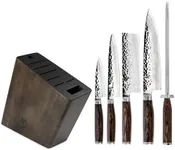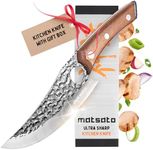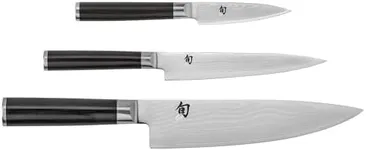Buying Guide for the Best Japanese Chef Knives
Choosing the right Japanese chef knife can significantly enhance your cooking experience. Japanese knives are known for their precision, sharpness, and craftsmanship. When selecting a Japanese chef knife, it's important to consider various factors to ensure you get the best fit for your needs. Here are some key specifications to help you make an informed decision.Blade MaterialThe blade material is crucial as it affects the knife's sharpness, durability, and maintenance. Common materials include stainless steel, high-carbon steel, and Damascus steel. Stainless steel is resistant to rust and easy to maintain, making it suitable for everyday use. High-carbon steel is extremely sharp and holds its edge well but requires more care to prevent rust. Damascus steel is known for its beautiful patterns and combines the benefits of both stainless and high-carbon steel. Choose stainless steel for low maintenance, high-carbon steel for superior sharpness, and Damascus steel for a balance of aesthetics and performance.
Blade LengthBlade length determines the knife's versatility and ease of use. Common lengths range from 6 to 12 inches. Shorter blades (6-8 inches) offer better control and are ideal for precision tasks like slicing vegetables or filleting fish. Longer blades (9-12 inches) are more versatile and can handle larger tasks like cutting meat or chopping large vegetables. Consider a shorter blade for detailed work and a longer blade for general-purpose use.
Blade EdgeThe blade edge affects the knife's cutting performance. There are three main types: straight edge, serrated edge, and granton edge. A straight edge is ideal for clean, precise cuts and is the most common type for chef knives. A serrated edge is useful for cutting through tough or crusty surfaces, like bread. A granton edge has small indentations that create air pockets, reducing friction and preventing food from sticking to the blade. Choose a straight edge for general use, a serrated edge for specific tasks like slicing bread, and a granton edge for smoother cuts with less sticking.
Handle MaterialThe handle material impacts the knife's comfort and grip. Common materials include wood, plastic, and composite. Wooden handles offer a traditional look and feel but require more maintenance to prevent damage from moisture. Plastic handles are durable, easy to clean, and often have ergonomic designs for a comfortable grip. Composite handles combine the benefits of wood and plastic, offering durability and a comfortable grip. Choose a handle material that feels comfortable in your hand and suits your maintenance preferences.
Weight and BalanceThe weight and balance of a knife affect how it feels during use. A well-balanced knife will feel comfortable and reduce fatigue during extended use. Heavier knives provide more power for cutting through tough ingredients, while lighter knives offer better control and precision. Test the knife in your hand to see if it feels balanced and comfortable. Choose a heavier knife for tasks that require more force and a lighter knife for precision work.
Blade ShapeThe blade shape influences the knife's functionality. Common shapes include gyuto (chef's knife), santoku (multi-purpose knife), and nakiri (vegetable knife). A gyuto has a curved edge, making it versatile for various tasks like slicing, dicing, and chopping. A santoku has a flatter edge, ideal for precise cuts and chopping vegetables. A nakiri has a straight edge, perfect for slicing vegetables with a push-cutting motion. Choose a gyuto for all-around use, a santoku for precision and versatility, and a nakiri for dedicated vegetable preparation.





















